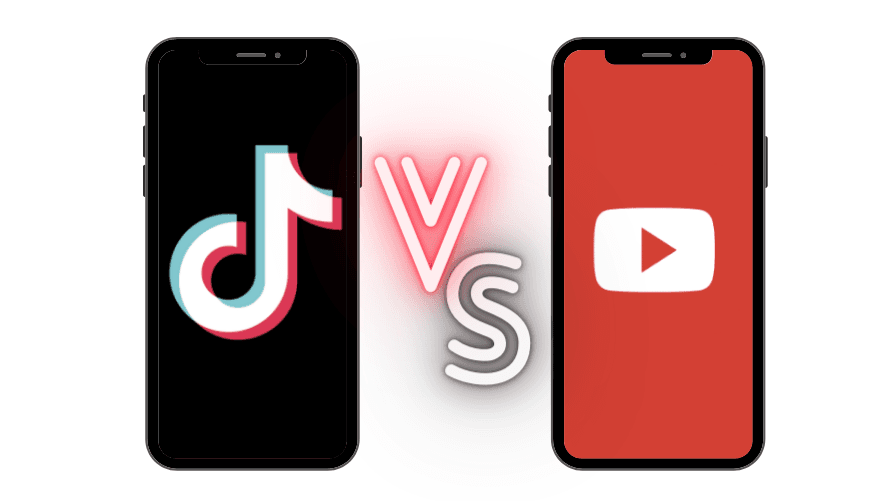TikTok vs YouTube: Which is The Better Marketing Platform?
TikTok has changed the game in social media. This fact is obvious when every social network has been scrambling to build short-form video functionality into their platform. Every disruptive innovation inevitably brings competition. And competition is good.

Nov 11 2021●5 min read

This time, let’s talk about why it’s good for marketers. There are 3 main benefits that TikTok vs YouTube competition brings:
- Capturing bigger and younger audiences;
- More influencers to choose from;
- More opportunities to hold customer attention.
TikTok vs YouTube
If you’re coming here from our newsletter, you’ve already read the brief take on this most recent beef. Both online video giants are steadily encroaching on each other’s territory with new functions and apps. But in case you’re not (you should though, here), here’s the outline of the most recent developments both platforms made:
- YouTube’s Shorts have exited the trial phase in India and arrived in the US in March of this year;
- In July, Shorts became available in more than 100 countries and averaged 15 billion daily views;
- Shorts allow up to 60-second videos with very similar functionality as TikTok (yet another clone);
- YouTube has implemented a function where their mobile app takes users straight to Shorts instead of the classic YouTube feed if they used Shorts at least once.
Meanwhile, TikTok is testing out longer video formats. Paired with other new functionalities, the breakout social network is challenging YouTube directly. Here’s how:
- This summer, TikTok enabled 3-minute video format, allowing creators to generate longer-format content;
- TikTok is also testing out 5-minute video format, as well as even longer, 10-minute videos;
- TikTok now ranks 5th for the most popular short video platform in the US;
- A big move for TikTok was to enable its app for desktop, consoles and web, as well as partnering with Amazon Fire TV. Now users can download the TikTok app from Amazon’s app store, create an account and browse their feeds straight from their TV.
So what does this mean for marketers?
Let’s start with audiences. YouTube is a giant. It has 223M unique viewers in the US. That is a gigantic pool of potential customers. As a marketing channel, YouTube nets at $6.8B of ad revenues in 2021, and the number is expected to grow, especially with accessibility to internet services like Spectrum internet. YouTube has an audience and marketers are tapping into it.
In contrast, TikTok has 130M unique active users in the US. And with $500M revenue reported in the US, TikTok looks like a small player compared to YouTube.
So why is YouTube scrambling with Shorts? Well, it’s in the audience age. 60% of TikTok’s audience are between the ages of 16-24. Meanwhile, on YouTube, the same audience accounts for roughly 22%. It’s these people that YouTube is looking to capture. But why?
I call it an investment into the future. 16-24-year-olds are becoming market participants. They’re making income and they’re becoming a consumer that advertisers want. And YouTube will do what advertisers want because of those billions in ad revenue we mentioned earlier. TikTok is doing everything to retain that audience - and perhaps attract different segments. And responding to the audience’s needs means going deeper into medium to long-video territory where YouTube is at.
For marketers, this means more content distribution channels, more advertising possibilities and greater access to customers.
Influencer marketing
So we have extra marketing channels, bigger and younger audiences. Time to talk about how to reach those audiences: influencers.
Influencer advertising is popular with 16-24-year-olds. Mostly because the vast majority of them grew up with social media. TikTok records having 3.1M influencers (accounts with more than 1000 followers). YouTube’s numbers are harder to gauge, but according to Mediakix, there are between 1.5M and 5M YouTube influencer accounts (again, with at least 1000 followers).
Let me emphasize how insane that is! TikTok cannot hold a candle to YouTube’s viewership, but boasts about the same number of influencers!
As a marketer, this is wonderful news. Not only there are more channels to choose from, but there are also more influencers to pick from too. You can narrow down your audience for the best ROI based on the influencer and the platform.
Bonus good news: according to the supply and demand theory, the ridiculous number of influencers on both platforms is good for marketers. There’s a lot of demand for influencers, meaning if the supply keeps increasing, the price will eventually drop.
Attention!
Finally, let’s talk about attention. If you’re a regular on our articles, you know we like to talk about customer attention. It’s the prime commodity when it comes to advertising. Having such strong marketing channels with audiences used to getting shopping information from influencers - it’s a great way to have a recognizable brand.
Not to say that marketing on multiple platforms is inexpensive. Influencer spending in the US is marked at $3.6B this year and is projected to grow. But with platforms competing for the same audiences with accessible creative tools, the volume might get higher, but the prices should get lower. And repetition is the best way to ensure brand recognition - and to get customer attention.
Final thoughts
So, where is this all going? Will social networks all end up the same, with similar video formats, same influencers re-sharing the same content over and over? Maybe. But one thing is for sure: there haven’t been platforms available for marketers to operate in. Whatever you choose, the numbers look good, the audience is engaged and the performance is set to grow. Watch the space!

WRITTEN BY
Indrė Jankutė-CarmaciuIndrė is a copywriter at Whatagraph with extensive experience in search engine optimization and public relations. She holds a degree in International Relations, while her professional background includes different marketing and advertising niches. She manages to merge marketing strategy and public speaking while educating readers on how to automate their businesses.